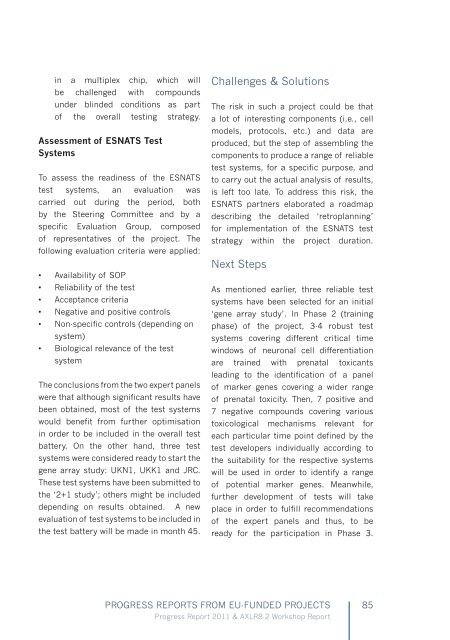You also want an ePaper? Increase the reach of your titles
YUMPU automatically turns print PDFs into web optimized ePapers that Google loves.
in a multiplex chip, which will<br />
be challenged with compounds<br />
under blinded conditions as part<br />
of the overall testing strategy.<br />
Assessment of ESNATS Test<br />
Systems<br />
To assess the readiness of the ESNATS<br />
test systems, an evaluation was<br />
carried out during the period, both<br />
by the Steering Committee and by a<br />
specific Evaluation Group, composed<br />
of representatives of the project. The<br />
following evaluation criteria were applied:<br />
• Availability of SOP<br />
• Reliability of the test<br />
• Acceptance criteria<br />
• Negative and positive controls<br />
• Non-specific controls (depending on<br />
system)<br />
• Biological relevance of the test<br />
system<br />
The conclusions from the two expert panels<br />
were that although significant results have<br />
been obtained, most of the test systems<br />
would benefit from further optimisation<br />
in order to be included in the overall test<br />
battery. On the other hand, three test<br />
systems were considered ready to start the<br />
gene array study: UKN1, UKK1 and JRC.<br />
These test systems have been submitted to<br />
the ‘2+1 study’; others might be included<br />
depending on results obtained. A new<br />
evaluation of test systems to be included in<br />
the test battery will be made in month 45.<br />
Challenges & Solutions<br />
The risk in such a project could be that<br />
a lot of interesting components (i.e., cell<br />
models, protocols, etc.) and data are<br />
produced, but the step of assembling the<br />
components to produce a range of reliable<br />
test systems, for a specific purpose, and<br />
to carry out the actual analysis of results,<br />
is left too late. To address this risk, the<br />
ESNATS partners elaborated a roadmap<br />
describing the detailed ‘retroplanning’<br />
for implementation of the ESNATS test<br />
strategy within the project duration.<br />
Next Steps<br />
As mentioned earlier, three reliable test<br />
systems have been selected for an initial<br />
‘gene array study’. In Phase 2 (training<br />
phase) of the project, 3-4 robust test<br />
systems covering different critical time<br />
windows of neuronal cell differentiation<br />
are trained with prenatal toxicants<br />
leading to the identification of a panel<br />
of marker genes covering a wider range<br />
of prenatal toxicity. Then, 7 positive and<br />
7 negative compounds covering various<br />
toxicological mechanisms relevant for<br />
each particular time point defined by the<br />
test developers individually according to<br />
the suitability for the respective systems<br />
will be used in order to identify a range<br />
of potential marker genes. Meanwhile,<br />
further development of tests will take<br />
place in order to fulfill recommendations<br />
of the expert panels and thus, to be<br />
ready for the participation in Phase 3.<br />
PROGRESS REPORTS FROM EU-FUNDED PROJECTS<br />
Progress Report 2011 & AXLR8-2 Workshop Report<br />
85




